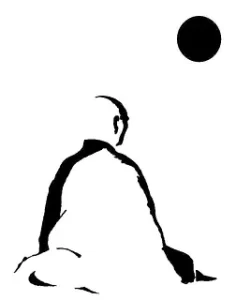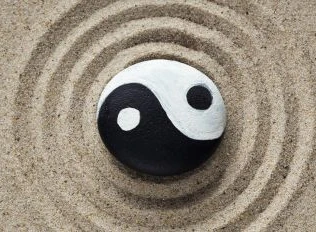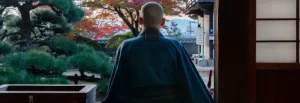In this article, we delve deep into the world of Zen Koans, examining their meaning and significance, presenting famous Zen Koan examples, and pointing you toward books on Zen Koans that can guide you on this transformative journey.
In the serene realm of Zen Buddhism, where the path to enlightenment winds through the tranquil landscapes of the mind, the art of contemplation finds its most profound expression in the enigmatic world of Zen Koans. These short and often puzzled statements, questions, or anecdotes have captivated seekers of spiritual wisdom for centuries, offering a gateway to profound insight and self-realization.

What is Zen Koan?
A koan is a riddle or puzzle that Zen Buddhists use during meditation to help them unravel greater truths about the world and themselves. Koans are often described as “surprising, surreal, and frequently contradictory.”
There is a tradition of koan study aimed at transforming one’s heart and the way they engage with the world. Koans don’t explain things; instead, they reveal something by opening a gate. Zen masters have been testing their students with these stories, questions, or phrases for centuries. Many koans can be traced back to the collections of sayings amassed by Chinese priests in the 12th and 13th centuries.
Typically, when we seek to understand something, we take it to the top floor and find a labeled shelf for it. However, if we approach meditation this way, it remains detached from our own lives. Instead, you can invite the koan into your heart and body, allowing it to bring about change.
The most important thing is not to judge, or find fault with anything that arises in your mind, including your progress with the koan. If you find yourself unable to avoid such judgments, don’t criticize that either. This is where compassion can come in.
Koan Meditation in Zen Buddhism
Koans are not about finding definitive answers; they are about realizing that our intellectual faculties can never provide us with a wholly satisfying solution. Even if you believe you have found an answer, responding with an answer is not the objective. The teacher determines when the student has grasped the koan properly, and this realization may manifest as a smile, a certain look in their eye, or simply in the observation of their posture as they grapple with and eventually yield to the statement.

Zen koans are meant to be understood through the spirit and intuition.
- Read the koan aloud to yourself. Try to memorize it.
- Observe your thoughts and emotions.
- Read the koan again and again throughout a day. Notice how your reactions and feelings change.
- Think of the koan as a friend who follows you around and is always there. Take your koan to work, to bed, to sleep, to a bar, to a Zoom call, to the impossible family problem, to the night when the racing clouds open, and a few stars shine through.
- There’s no need to judge, assess, criticize, evaluate, condemn, or find fault with your thoughts.
- At the end of the day, find a quiet place with no disturbance whatsoever and meditate on the koan.
- Wake up and read the koan again. Start with step 1.
You’ll wonder if you are doing it right remember that you can’t do it wrong. Koan is just like poetry or love. Everyone has a different experience.
List of Zen Koans
- Bells and Robes
- If you practice sitting as Buddha, you must kill Buddha
- Wash you bowls
- Is That So?
- Right & Wrong
- Impermanence
- Flow Like a River
Short Zen Koans
Bells and Robes

Zen Master Unmon said: “The world is vast and wide. Why do you put on your robes at the sound of a bell?”
If you practice sitting as Buddha, you must kill Buddha

When asked why he practiced zen, the student said, “Because I intend to become a Buddha.”
His teacher picked up a brick and started polishing it. The student asked “What are you doing?” The teacher replied, “I am trying to make a mirror.”
“How can you make a mirror by polishing a brick?”
“How can you become Buddha by doing zazen? If you understand sitting Zen, you will know that Zen is not about sitting or lying down. If you want to learn sitting Buddha, know that sitting Buddha is without any fixed form. Do not use discrimination in the non-abiding dharma. If you practice sitting as Buddha, you must kill Buddha. If you are attached to the sitting form, you are not yet mastering the essential principle.”
The student heard this admonition and felt as if he had tasted sweet nectar. — Dōgen Zenji
Wash you bowls

Once a monk made a request of Joshu.
“I have just entered the monastery,” he said. “Please give me instructions, Master.”
Joshu said, “Have you had your breakfast?”
“Yes, I have,” replied the monk.
“Then,” said Joshu, “wash your bowls.”
The monk had an insight.
The monk had an insight.
The Zen master Hakuin was praised by his neighbours as one living a pure life.
A beautiful Japanese girl whose parents owned a food store lived near him. Suddenly, without any warning, her parents discovered she was with child.
This made her parents angry. She would not confess who the man was, but after much harassment at last named Hakuin.
In great anger the parent went to the master. “Is that so?” was all he would say.
After the child was born it was brought to Hakuin. By this time he had lost his reputation, which did not trouble him, but he took very good care of the child. He obtained milk from his neighbours and everything else he needed.
A year later the girl-mother could stand it no longer. She told her parents the truth – the real father of the child was a young man who worked in the fishmarket.
The mother and father of the girl at once went to Hakuin to ask forgiveness, to apologize at length, and to get the child back.
Hakuin was willing. In yielding the child, all he said was: “Is that so?
Right & Wrong
When Bankei held his seclusion-weeks of meditation, pupils from many parts of Japan came to attend. During one of these gatherings a pupil was caught stealing. The matter was reported to Bankei with the request that the culprit be expelled. Bankei ignored the case.
Later the pupil was caught in a similar act, and again bankei disregarded the matter. this angered the other pupils, who drew up a petition asking for the dismissal of the thief, stating that otherwise they woudl leave in a body.
When bankei had read the petition he called everyone before him. “You are wise brothers,” he told them. “You know what is right and what is not right. You may somewhere else to study if ou wish, but this poor brother does not even know right from wrong. Who will teach him if I do not? I am going to keep him here even if all the rest of you leave.”
A torrent of tears cleansed the face of the brother who had stolen. All desire to steal had vanished.
Impermanence
A man traveling across a field encountered a tiger. He fled, the tiger after him.
Coming to a precipice, he caught hold of the root of a wild vine and swung himself down over the edge.
The tiger sniffed at him from above.
Trembling, the man looked down to where, far below, another tiger was waiting to eat him. Only the vine sustained him.
Two mice, one white and one black, little by little started to gnaw away the vine.
The man saw a luscious strawberry near him. Grasping the vine with one hand, he plucked the strawberry with the other.
How sweet it tasted!
These koans, or parables, were translated into English from a book called the Shaseki-shu (Collection of Stone and Sand), written late in the thirteenth century by the Japanese Zen teacher Muju (the “non-dweller”), and from anecdotes of Zen monks taken from various books published in Japan around the turn of the 20th century.
Flow Like a River

There is the story of a young martial arts student who was under the tutelage of a famous master. One day, the master was watching a practice session in the courtyard. He realized that the presence of the other students was interfering with the young man’s attempts to perfect his technique.
The master could sense the young man’s frustration. He went up to the young man and tapped him on his shoulder.
“What’s the problem?” he inquired.
“I don’t know”, said the youth, with a strained expression.
“No matter how much I try, I am unable to execute the moves properly”.
“Before you can master technique, you must understand harmony. Come with me, I will explain”, replied the master.
The teacher and student left the building and walked some distance into the woods until they came upon a stream. The master stood silently on the bank for several moments. Then he spoke.
“Look at the stream,” he said. “There are rocks in its way. Does it slam into them out of frustration? It simply flows over and around them and moves on! Be like the water and you will know what harmony is.”
The young man took the master’s advice to heart. Soon, he was barely noticing the other students around him. Nothing could come in his way of executing the most perfect moves.
Zen koans books:
- Zen Koans by Kubose, Gyomay M.
- Zen Mind, Beginner’s Mind: Informal Talks on Zen Meditation and Practice
- 101 Zen Koans by Katsuki Ohgami
- Introduction to Zen Koans: Learning the Language of Dragons
- The Gateless Gate: The Classic Book of Zen Koans







